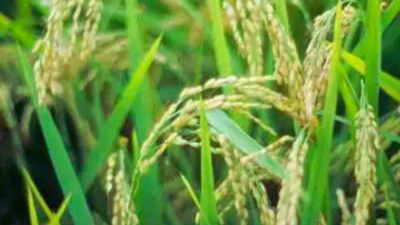- News
- City News
- lucknow News
- Uttar Pradesh govt eyeing record paddy yield for second successive year
Uttar Pradesh govt eyeing record paddy yield for second successive year

The state government expects the paddy yield to increase by one million tonnes in the current Kharif season.
LUCKNOW: The UP government expects to set a new record in paddy production for a second year in a row this year, the state government said in a statement on Sunday. This comes in the backdrop of the area under cultivation of paddy increasing from 58.92 to 60 lakh hectares, favourable weather conditions, better rains and the measures taken by the state government.
The state government expects the paddy yield to increase by one million tonnes in the current Kharif season. Last year, the production of paddy had crossed 257.04 lakh tonnes. Notably, the agriculture department had set a target of cultivating paddy on 60 lakh hectares of land out of 96.03 lakh hectares in this Kharif season. Of this, sowing had been done on 57.72 lakh hectares till August 4. Sowing of paddy on the remaining land is likely to be completed by August 15.
A state government spokesperson said that UP is likely to set a new record in the production of coarse cereals like millet and maize as well due to the conducive weather.
Out of 18 divisions in the state, the production of paddy is likely to be the highest in Bareilly division where maximum sowing has been done. In Bareilly division, paddy has been sown on 194.40 thousand hectares of land followed by 175.50 thousand hectares in Moradabad division, 156.01 thousand hectares in Meerut division, 141.40 thousand hectares in Aligarh division, 73.72 thousand hectares in Saharanpur division and 25 thousand hectares in Vindhyachal division.
The spokesperson said that even during the second wave of pandemic, CM Yogi Adityanath ensured that agricultural programmes continued uninterrupted. “There was no shortage of manure and seeds in the state. The Government also ensured that there was also no shortage of fertilizers like urea, DAP, NPK, zinc and potash while the movement of machines for harvesting wheat continued as usual. Agricultural equipment and improved seeds were also made available to the farmers, which led to significant increase in the production of rabi crops. And now the Government is leaving no stone unturned to have a record production of kharif crops including millet, maize, mung, groundnut, soybean, sesame and toor this year,” he said.
The state government, officials said, is also working on increasing the storage capacity for food grains in view of the estimated increase in production. In 2017, the total storage capacity in the state was close to 29 lakh tonnes, which has been increased by the state government to more than 51 lakh tonnes in just three years. The Government has set a target to increase storage capacity to 7 million tonnes by the year 2022.
The state government expects the paddy yield to increase by one million tonnes in the current Kharif season. Last year, the production of paddy had crossed 257.04 lakh tonnes. Notably, the agriculture department had set a target of cultivating paddy on 60 lakh hectares of land out of 96.03 lakh hectares in this Kharif season. Of this, sowing had been done on 57.72 lakh hectares till August 4. Sowing of paddy on the remaining land is likely to be completed by August 15.
A state government spokesperson said that UP is likely to set a new record in the production of coarse cereals like millet and maize as well due to the conducive weather.
Out of 18 divisions in the state, the production of paddy is likely to be the highest in Bareilly division where maximum sowing has been done. In Bareilly division, paddy has been sown on 194.40 thousand hectares of land followed by 175.50 thousand hectares in Moradabad division, 156.01 thousand hectares in Meerut division, 141.40 thousand hectares in Aligarh division, 73.72 thousand hectares in Saharanpur division and 25 thousand hectares in Vindhyachal division.
The spokesperson said that even during the second wave of pandemic, CM Yogi Adityanath ensured that agricultural programmes continued uninterrupted. “There was no shortage of manure and seeds in the state. The Government also ensured that there was also no shortage of fertilizers like urea, DAP, NPK, zinc and potash while the movement of machines for harvesting wheat continued as usual. Agricultural equipment and improved seeds were also made available to the farmers, which led to significant increase in the production of rabi crops. And now the Government is leaving no stone unturned to have a record production of kharif crops including millet, maize, mung, groundnut, soybean, sesame and toor this year,” he said.
The state government, officials said, is also working on increasing the storage capacity for food grains in view of the estimated increase in production. In 2017, the total storage capacity in the state was close to 29 lakh tonnes, which has been increased by the state government to more than 51 lakh tonnes in just three years. The Government has set a target to increase storage capacity to 7 million tonnes by the year 2022.
FacebookTwitterLinkedinEMail
Start a Conversation
end of article
Quick Links
Delhi Air PollutionDelhi TemperatureChennai WeatherBangalore TemperatureCovid vaccination centres in DelhiCoronavirus in DelhiRTPCR test in GurgaonHyderabad RainPollution level in BangaloreDelhi SmogDelhi TemperatureNoida AQIGurgaon AQI todayFire in MumbaiMumbai RainsCovid 19 RT PCR Test in NoidaDelhi AQI todaySrinagar encounter

